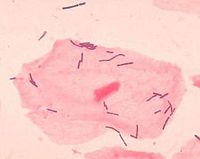Lactobacillus plantarum: Difference between revisions
imported>Jennifer Yoon No edit summary |
imported>Jennifer Yoon No edit summary |
||
| Line 18: | Line 18: | ||
==Genome structure== | ==Genome structure== | ||
In 2003, Michiel Kleerebezem mapped out the complete genome of Lactobacillus plantarum WCFS1. Lactobacillus plantarum strain WCFS1 is known to have 3,308,274 base pairs and contains 3,052 protein-encoding genes as well as three plasmids (1,917-bp, 2,365-bp, and 36,069-bp,) which accounts for its high adaptability. The G+C content of the chromosome is 44.5%, but the plasmids contain slightly less G+C content. [http://www.pnas.org/content/100/4/1990.full 1] | In 2003, Michiel Kleerebezem mapped out the complete genome of Lactobacillus plantarum WCFS1. Lactobacillus plantarum strain WCFS1 is known to have 3,308,274 base pairs and contains 3,052 protein-encoding genes as well as three plasmids (1,917-bp, 2,365-bp, and 36,069-bp,) which accounts for its high adaptability. The G+C content of the chromosome is 44.5%, but the plasmids contain slightly less G+C content. [http://www.pnas.org/content/100/4/1990.full 1] | ||
==Cell structure and metabolism== | ==Cell structure and metabolism== | ||
Lactobacillus plantarum is a gram positive, rod-shaped, organotrophic, bacteria often called lactic acid bacteria because it gets most of its energy from converting glucose to lactate via fermentation. | Lactobacillus plantarum is a gram positive, rod-shaped, organotrophic, bacteria often called lactic acid bacteria because it gets most of its energy from converting glucose to lactate via homolactic and heterolactic fermentation. Homolactic fermentation uses the EMP pathway and heterolactic fermentation uses the phosphoketolase pathway.[http://microbewiki.kenyon.edu/index.php/Lactobacillus 2] [http://www.pnas.org/content/100/4/1990.full 1] | ||
==Ecology== | ==Ecology== | ||
Lactobacillus plantarum grows best at temperatures between 30º to 60º Celsius. | |||
==Pathology== | ==Pathology== | ||
Revision as of 21:53, 21 April 2009
For the course duration, the article is closed to outside editing. Of course you can always leave comments on the discussion page. The anticipated date of course completion is May 21, 2009. One month after that date at the latest, this notice shall be removed. Besides, many other Citizendium articles welcome your collaboration! |
 | ||||||||||||||
| Scientific classification | ||||||||||||||
| ||||||||||||||
| Binomial name | ||||||||||||||
Genome structure
In 2003, Michiel Kleerebezem mapped out the complete genome of Lactobacillus plantarum WCFS1. Lactobacillus plantarum strain WCFS1 is known to have 3,308,274 base pairs and contains 3,052 protein-encoding genes as well as three plasmids (1,917-bp, 2,365-bp, and 36,069-bp,) which accounts for its high adaptability. The G+C content of the chromosome is 44.5%, but the plasmids contain slightly less G+C content. 1
Cell structure and metabolism
Lactobacillus plantarum is a gram positive, rod-shaped, organotrophic, bacteria often called lactic acid bacteria because it gets most of its energy from converting glucose to lactate via homolactic and heterolactic fermentation. Homolactic fermentation uses the EMP pathway and heterolactic fermentation uses the phosphoketolase pathway.2 1
Ecology
Lactobacillus plantarum grows best at temperatures between 30º to 60º Celsius.
Pathology
Application to Biotechnology
Current Research
References
- Michiel Kleerebezem, Jos Boekhorst, Richard van Kranenburg, Douwe Molenaar, Oscar P. Kuipers, Rob Leer, Renato Tarchini, Sander A. Peters, Hans M. Sandbrink, Mark W. E. J. Fiers, Willem Stiekema, René M. Klein Lankhorst, Peter A. Bron, Sally M. Hoffer, Masja N. Nierop Groot, Robert Kerkhoven, Maaike de Vries, Björn Ursing, Willem M. de Vos*, and Roland J. Siezen. (2003). Complete genome sequence of Lactobacillus plantarum WCFS1. Proceedings of the National Academy of Sciences, 100 (4), 1990-1995.
- http://microbewiki.kenyon.edu/index.php/Lactobacillus